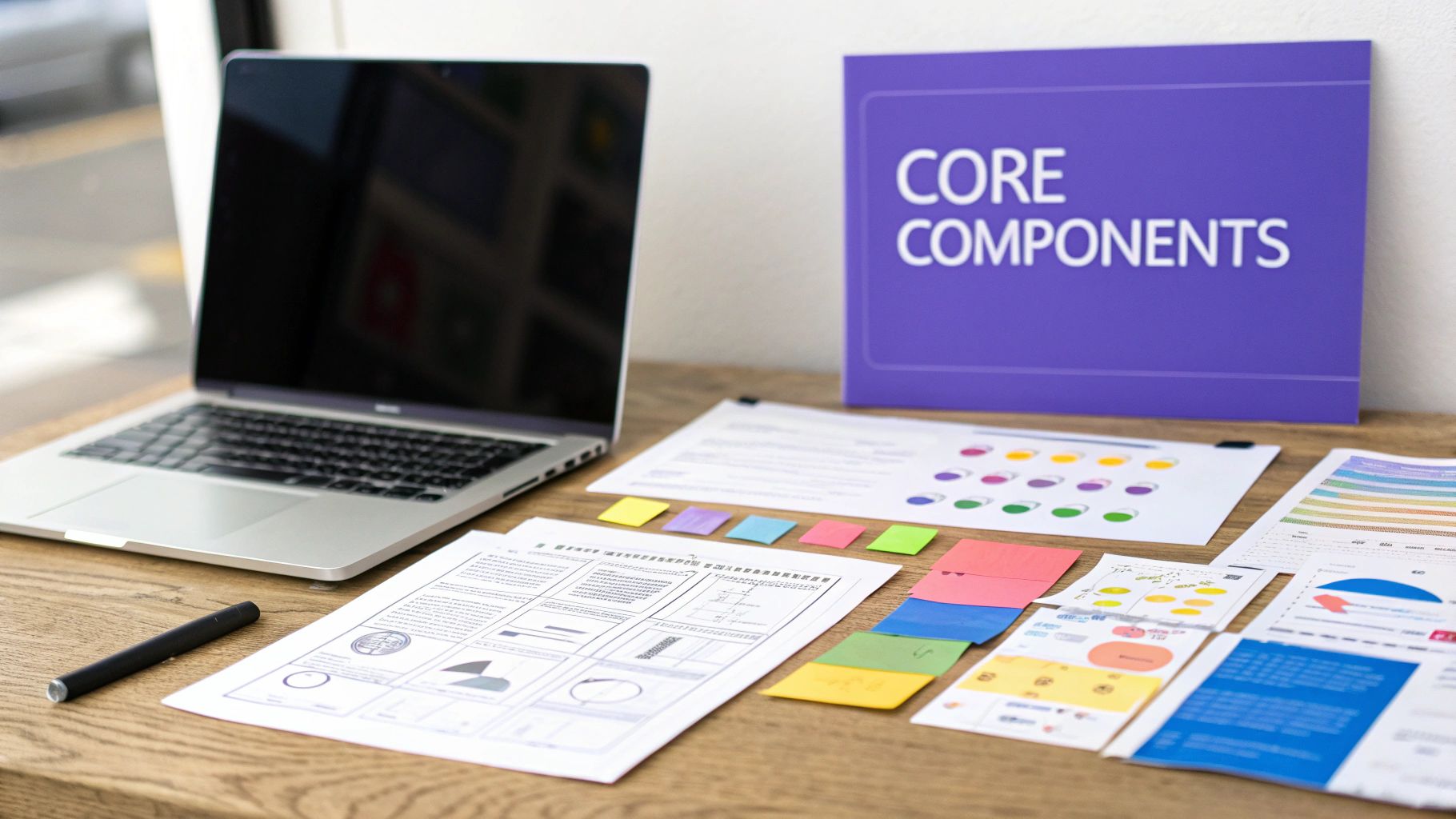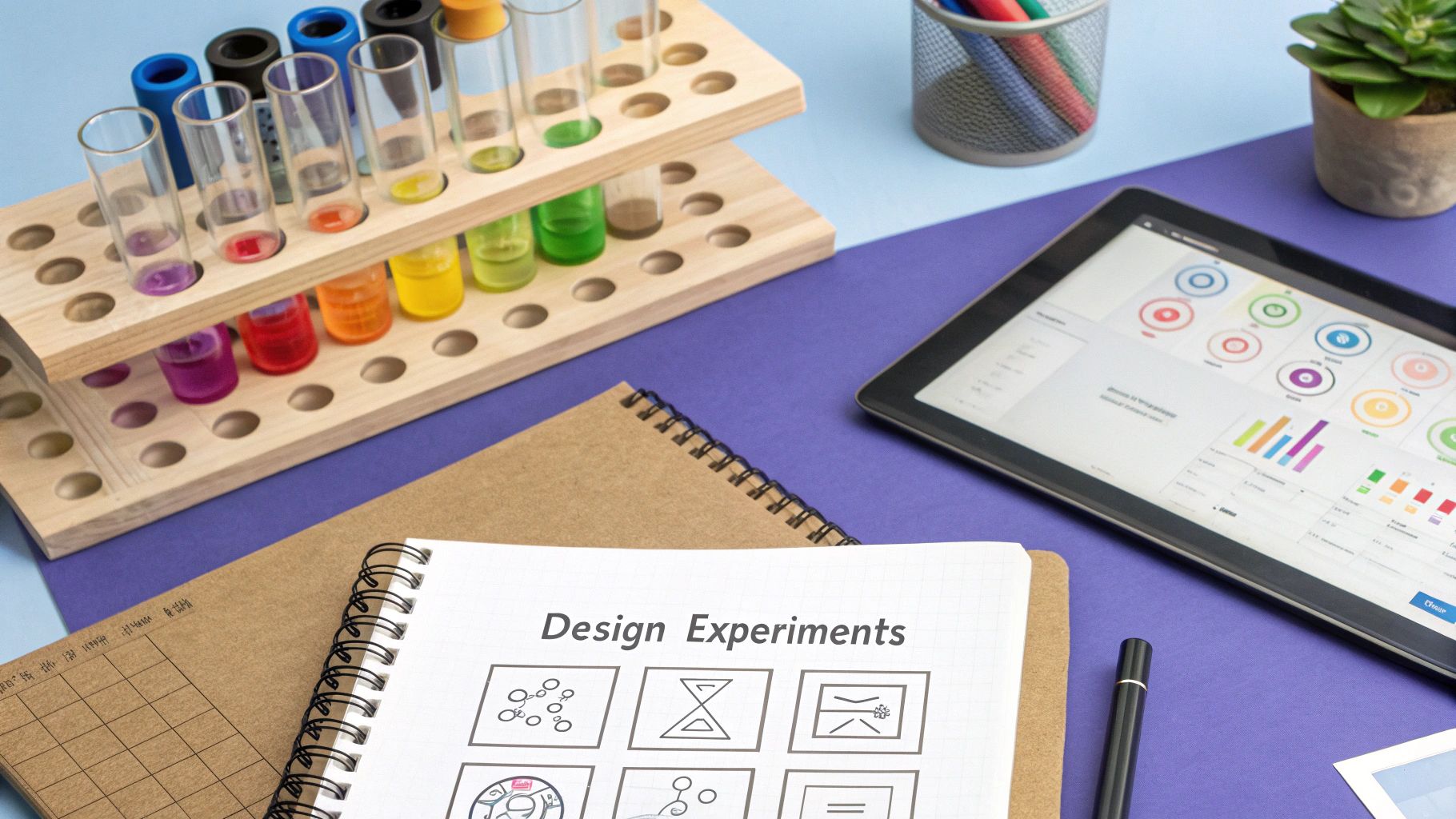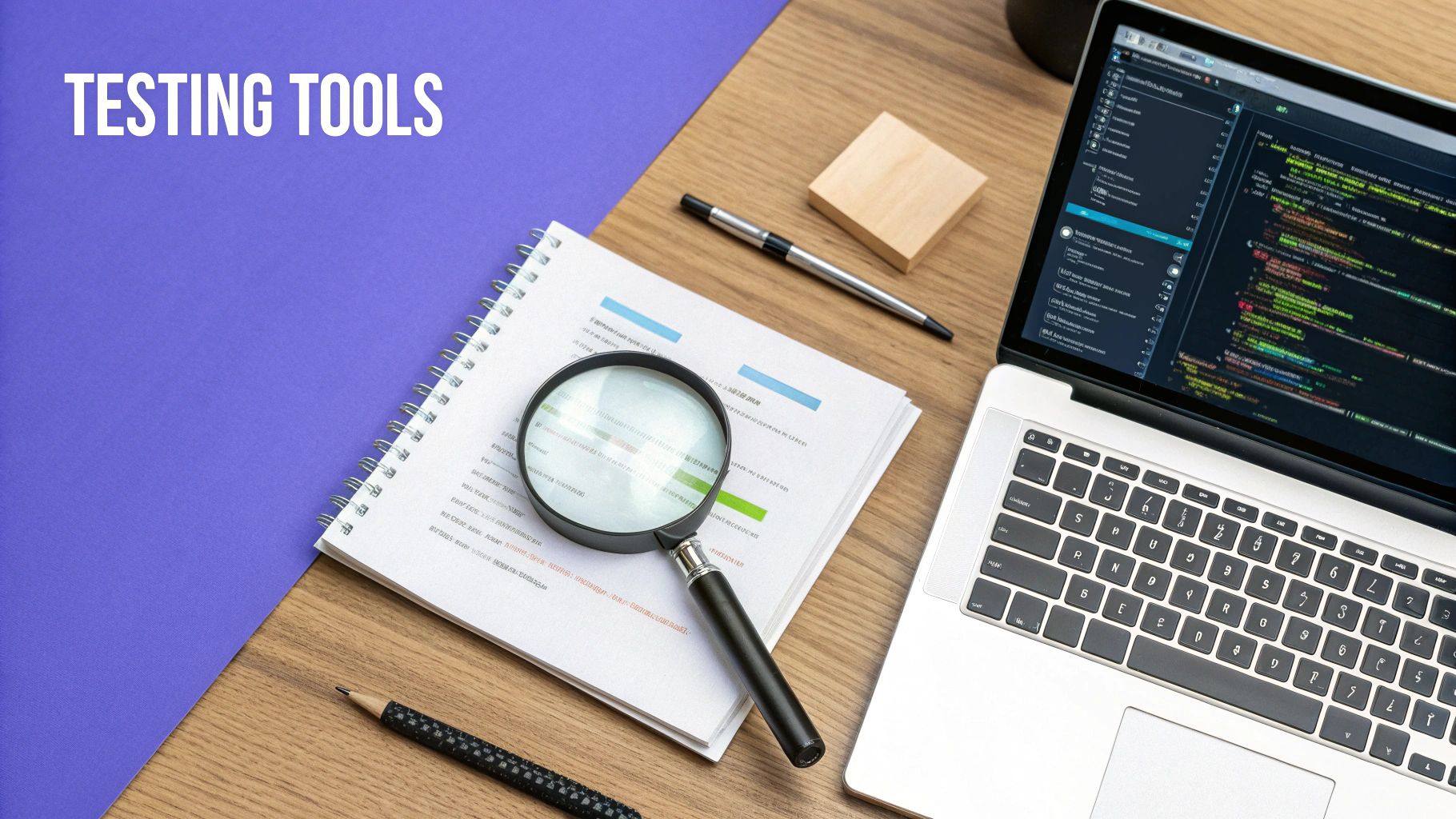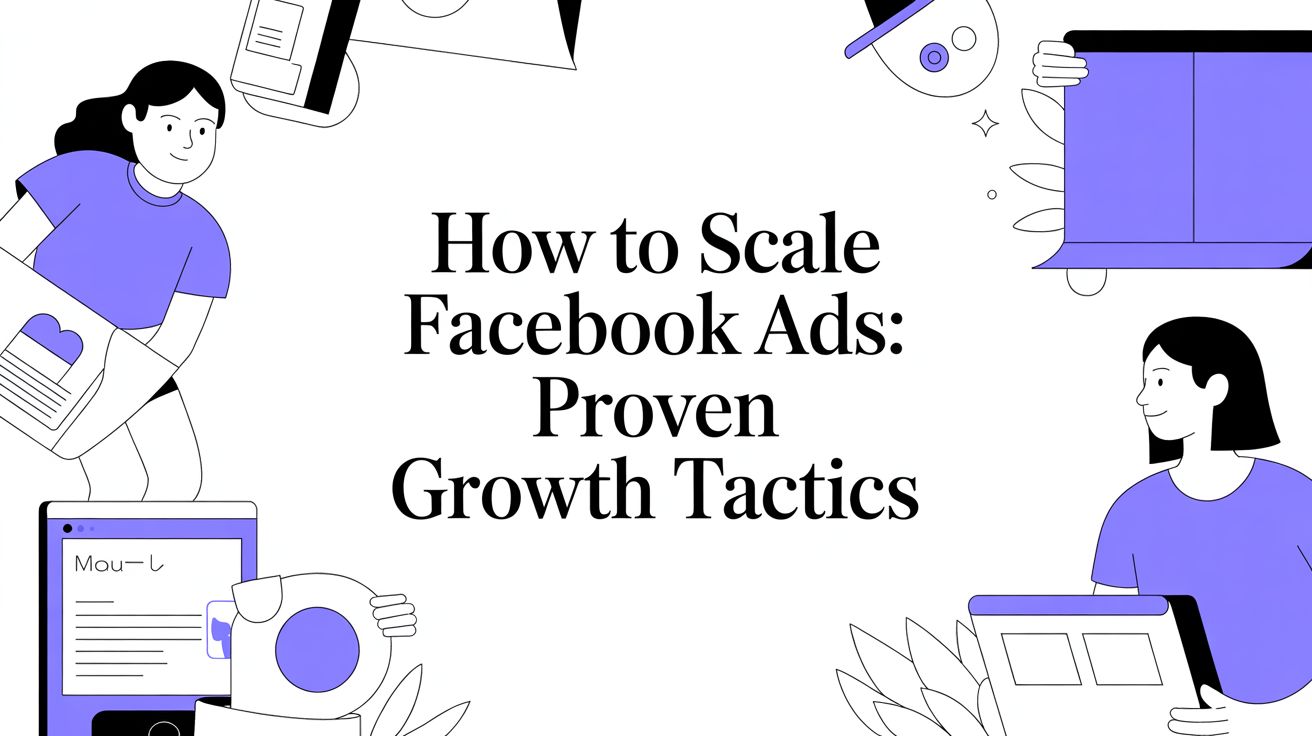Why Your Creative Testing Framework Makes or Breaks Performance
A well-structured creative testing framework is essential for success in competitive digital advertising. Many marketers launch campaigns hoping for the best, essentially gambling with their ad budgets. However, successful brands and agencies recognize the power of data-driven approaches. They invest in structured testing processes, transforming advertising from guesswork into a predictable growth engine.
This shift is crucial because it eliminates costly trial and error, which often drains marketing resources. By treating creative testing scientifically, rather than relying on intuition, these companies gain a significant advantage. This systematic approach helps them understand what resonates with their target audience.
The Power of Predictable Growth
A creative testing framework allows for informed decisions based on data, not gut feelings. Imagine two ad variations: one demonstrates the product, the other features customer testimonials. A framework lets you test both simultaneously, gathering data on click-through rates, conversions, and other metrics. This allows confident investment in the higher-performing creative, maximizing return on investment (ROI). These insights can then be applied to future campaigns, creating a continuous improvement cycle.
Creative testing frameworks have proven crucial for enhancing ad performance. For example, a founder-focused campaign by Tuff Growth showed the effectiveness of creative testing. They observed a 23% lift in Click-Through Rate (CTR) and an 18% increase in conversions compared to the next best variation. This winning creative also led to a 9% reduction in Cost Per Acquisition (CPA), highlighting the importance of documenting and optimizing creative strategies.
From Intuition to Measurable Outcomes
Moving beyond guesswork leads to measurable results, sustainable growth, and the confidence to scale winning campaigns. This is the true power of a creative testing framework. It empowers you to:
Maximize ROI: Identify high-performing creatives to ensure effective budget allocation.
Achieve Sustainable Growth: Continuously improve creative through testing for long-term success.
Scale with Confidence: Expand your reach without wasting resources, knowing which creatives are effective.
Creative Testing as a Competitive Advantage
In crowded digital spaces, a well-defined creative testing framework offers a competitive edge. It provides the insights needed not just to survive, but to thrive. This systematic approach empowers data-backed decisions, ensuring every advertising dollar contributes to business objectives. It enables quick adaptation to changing markets and consistently delivers engaging, high-performing campaigns.
Building Your Creative Testing Framework Foundation
Building a robust creative testing framework takes time and effort. It begins with grasping the key principles that separate successful campaigns from expensive failures. This means moving past simply launching ads and hoping for the best. A strategic, data-driven approach is crucial.
Essential Components of a Successful Framework
Any effective framework relies on several core pillars:
Hypothesis Formation: Base your tests on solid audience insights. Interested in user-generated content? Check out this article: How to master user-generated content. Don't just guess—research your audience to develop informed hypotheses about what will truly connect with them.
Effective Test Design: Isolate variables to understand their impact. Testing multiple elements at once can obscure results, making it hard to see what's really driving performance.
Statistical Significance Planning: Avoid misleading conclusions by planning for statistical significance. This includes determining the required sample size and understanding confidence intervals.
Actionable Result Interpretation: Don't just collect data, understand it. Turn your results into concrete actions to improve future campaigns.
Setting Up Your Framework Infrastructure
A solid foundation requires more than just theory. It demands practical steps:
Establish Baseline Metrics: Determine the metrics that align with your business goals. These could include conversions, brand awareness, or other key performance indicators. Don't get sidetracked by vanity metrics that don't contribute to your bottom line.
Create a Testing Schedule: Incorporate testing into your workflow without disrupting successful campaigns. A structured schedule maintains consistency and prevents reactive, unplanned testing.
Build a Documentation System: Record the insights from every test, both positive and negative. This creates a valuable resource for future optimization.
Balancing Creative Intuition and Scientific Rigor
Data is essential, but don't underestimate the power of creative intuition. A successful framework balances both. Use data to validate creative ideas and highlight areas for improvement. This approach allows you to scale your testing efforts as your business and budget expand, ensuring you're always measuring what drives revenue, not just clicks.

By implementing these fundamental elements, you'll create a creative testing framework that delivers consistent, data-driven results and fuels sustained growth. This sets the stage for scaling winning campaigns and maximizing your advertising ROI.
Navigating Platform-Specific Testing Challenges
Different advertising platforms present unique obstacles for creative testing. Understanding these nuances is what separates successful creative testing frameworks from failed experiments. This involves recognizing how algorithms, timing, and platform-specific biases can significantly impact your results.
Algorithm Learning Phases and Your Tests
Advertising platforms like Meta, Google, and TikTok utilize algorithms to optimize ad delivery. These algorithms go through learning phases, gathering data about your target audience and creative performance. Disrupting this process with frequent changes to your creative testing framework can lead to inefficient spending and unreliable data.
It’s crucial to design your framework to work with these algorithms. Allow sufficient time for the learning phase to complete before making significant changes to your creatives.
The Importance of Timing in Creative Testing
Timing significantly impacts creative testing, affecting everything from campaign performance to budget allocation. Seasonal trends, day-of-week fluctuations, and even time-of-day variations can drastically skew your results.
For example, an ad targeting holiday shoppers will likely perform differently in December than in July. Your creative testing framework should account for these variables, incorporating testing schedules that align with relevant timeframes. This allows for accurate comparisons and prevents misleading conclusions based on temporary performance changes.
Platform-Specific Biases and Data Interpretation
Each platform has its own unique characteristics and audience demographics, creating inherent biases. For instance, established creatives often outperform new ones on platforms like Meta due to accumulated historical data. This data enhances performance through optimization algorithms.
However, this doesn't mean new creatives are ineffective. Rather, it underscores the importance of considering ad auction dynamics during testing. Explore this topic further. A video-heavy platform like TikTok may favor visually engaging content, while a text-based platform like Twitter might prioritize concise, witty copy.
Failing to account for these platform-specific biases can lead to misinterpretations of your test results and ineffective creative decisions. Consider the following image which depicts an example of a creative testing framework:

Practical Strategies for Platform-Specific Testing
To navigate these platform-specific complexities, incorporate these best practices:
Account for Learning Phases: Allow algorithms time to optimize before making changes.
Control for Timing: Conduct tests during comparable time periods.
Understand Platform Biases: Tailor creatives and testing to each platform.
Segment Your Audience: Test different creative variations on distinct audience segments.
By understanding and addressing these challenges, you can build a more robust creative testing framework, ensuring optimal campaign performance and maximizing your advertising ROI.
Scaling Winners and Learning From Losers
A truly effective creative testing framework goes beyond simply finding a winning variation. The real value lies in knowing how to scale those winning ads without compromising performance. Just as important is learning from the ads that didn't perform well. This involves a strategic approach to budget allocation, audience expansion, and creative iteration.
Scaling Winning Creatives: Maintaining Momentum
Scaling winning creatives requires a delicate balance. Pushing too aggressively can quickly lead to ad fatigue and decreased effectiveness.
Budget Allocation: Gradually increase the budget for your top-performing creative. Closely monitor performance metrics, such as conversion rate, to ensure continued efficiency. Avoid sudden, large increases that could negatively affect your cost per conversion.
Audience Expansion: Carefully expand the targeting of your successful ad to reach new potential customers. Start with lookalike audiences or similar interest groups to maintain high-quality conversions as you scale.
Creative Iteration: Instead of running the same ad indefinitely, create variations of your winner. This helps keep your messaging fresh and combats ad fatigue. Test these new versions against the original to identify even stronger performers.
You might be interested in: How to master multivariate testing for video creatives to further refine your approach.
Learning From Losing Creatives: Unearthing Valuable Insights
Winning ads are definitely worth celebrating. However, don’t dismiss the ads that didn't perform as well. They contain valuable data that can inform your future creative strategy.
Analyze Performance Data: Deep dive into the metrics of underperforming creatives. What was the click-through rate? At what point did people drop off in the conversion funnel? This data offers clues about your audience and their preferences.
Refine Hypotheses: Use the data from less successful ads to refine your understanding of what doesn't resonate with your audience. This knowledge leads to more focused hypotheses and more effective tests in the future.
Identify Trends: Analyzing multiple losing variations can reveal patterns. Perhaps certain image types consistently underperform, or specific calls to action fail to connect with your target audience.
For example, one company launched a large-scale ad testing campaign, releasing 70 static ads simultaneously. This approach enabled them to quickly gather data and identify winning variations. They scaled their ad spend by 74.6% while simultaneously reducing their Customer Acquisition Cost (CAC) by 40% in just three weeks. Learn more about the power of creative testing here.
Advanced Scaling Techniques: Sustaining Long-Term Success
For sustained growth, consider these advanced techniques:
Creative Refresh Cycles: Regularly introduce new creative variations to combat ad fatigue and keep engagement rates high.
Performance Monitoring: Continuously monitor key performance metrics, such as impressions and reach, to identify any decline in effectiveness early on. This proactive approach allows for adjustments before performance significantly drops.
Warning Indicators: Establish clear warning indicators that signal when a winning creative needs to be replaced. These indicators could include declining click-through rates, increasing cost per conversion, or decreasing conversion volume.

This bar chart visualizes average increases in Conversion Lift, Engagement Uplift, and improvements in Test Turnaround times when using a creative testing framework. As the infographic shows, a structured framework can significantly improve key performance indicators while also reducing the time needed for testing. This leads to quicker iterations and faster optimization. By strategically scaling winners and learning from losers, your creative testing framework becomes a powerful engine for continuous growth and improvement.
Advanced Creative Testing Strategies That Drive Results
Basic A/B testing is a good start, but it only scratches the surface. To really understand your audience and your messaging, you need to dig deeper. A more sophisticated creative testing framework unlocks these deeper insights into what makes your audience tick.
Multivariate Testing: Isolating Performance Drivers
Instead of just comparing two versions of something, multivariate testing lets you test multiple elements at once. Think headlines, images, calls to action – all in different combinations. This helps pinpoint the exact elements driving performance. Instead of knowing which version is better, you'll know why. For example, you might find that a specific headline paired with a particular image performs significantly better than other pairings.
This granular level of understanding allows you to optimize your creative for maximum impact.
Sequential Testing: Building on Previous Learnings
Sequential testing takes a dynamic, learn-as-you-go approach. Instead of setting a fixed sample size from the start, you analyze the data as it comes in. This lets you stop a test early if there's a clear winner. Or, you can adjust the test based on early findings. This adaptability saves time and resources, leading to more agile creative optimization.
Advanced Statistical Techniques: Revealing True Impact
Advanced statistical techniques can uncover subtle but important insights hidden in your data. Analyzing confidence intervals, for example, helps you avoid making decisions based on statistically insignificant results. This is especially crucial with smaller sample sizes. Understanding statistical significance helps you avoid costly mistakes by ensuring your results are reliable and not just due to chance.
Designing Tests for Specific Variables
A well-designed creative testing framework allows you to isolate specific variables for focused analysis. This granular approach helps you build a comprehensive picture of what works for your target customers. By systematically testing elements like headlines, visuals, call-to-actions, and even audience targeting, you gather actionable data to inform your creative strategy. For more streamlined approaches, check out this article: How to master automated creative testing.
To help you build a robust creative testing framework, take a look at the following table:
Creative Testing Framework Components
Essential elements and best practices for building effective creative testing frameworks
| Component | Purpose | Implementation | Success Metrics |
|---|---|---|---|
| Sample Size | Ensure statistically significant results. | Calculate based on desired confidence level and expected effect size. | Achieved statistical significance. |
| Confidence Intervals | Gauge the reliability of results. | Calculate and interpret intervals to understand result variability. | Narrow confidence intervals. |
| Variable Isolation | Pinpoint specific elements driving performance. | Design tests to isolate and analyze individual creative elements. | Clear attribution of performance drivers. |
| Multivariate Testing | Test multiple variations of elements simultaneously. | Use testing platforms that support multivariate testing. | Identification of optimal combinations. |
| Sequential Testing | Dynamically adjust tests based on incoming data. | Use testing platforms that support sequential analysis and adaptive testing. | Faster time to insights, efficient resource use. |
This table summarizes the key components of an effective testing framework, highlighting their purpose, implementation, and how to measure success. By incorporating these elements, you can ensure reliable results and actionable insights.
Practical Guidance for Reliable Results
For reliable test results, pay attention to these key factors:
Sample Size Calculations: Figure out the right sample size to get statistically significant results. This prevents drawing the wrong conclusions from insufficient data.
Confidence Intervals: Understand and use confidence intervals to avoid making premature decisions based on data fluctuations.
Avoiding Statistical Errors: Be mindful of common statistical traps, like confusing correlation with causation. These can lead to inaccurate conclusions and ineffective campaigns.
By implementing these advanced strategies, you transform your creative testing framework into a powerful tool for continuous improvement. This data-driven approach informs not only individual campaigns, but also broader marketing strategies, product development, and even overall business positioning.
Measuring Success and Continuous Optimization
Your creative testing framework is only as valuable as its measurement and optimization capabilities. Simply running tests isn't enough. You need to extract actionable insights that drive real business growth. This means looking beyond surface-level engagement and focusing on metrics that truly indicate creative success.
Key Metrics for Measuring Creative Success
True creative success goes beyond likes and shares. While engagement is important, it's crucial to focus on metrics aligned with your overall business objectives.
Some key metrics to consider:
Lifetime Value Impact: Does the creative contribute to long-term customer profitability? A high initial conversion rate is great, but does it lead to customers who stick around and make repeat purchases?
Brand Perception Changes: How does the creative influence how people view your brand? Even if it doesn't immediately drive conversions, it could contribute to positive brand sentiment and organic growth.
Performance Sustainability: Can the creative maintain its performance over time? A short-term spike in conversions isn't as valuable as sustained, consistent results.

Building Actionable Reporting Systems
Effective reporting avoids overwhelming you with vanity metrics. Instead, focus on providing clear, actionable insights.
Here's how:
Focus on Key Performance Indicators (KPIs): Select the metrics that directly relate to your business goals and track them diligently. Avoid getting bogged down in irrelevant data.
Visualize Data Effectively: Use charts and graphs to quickly identify trends and patterns. This makes it easier to spot opportunities for optimization. Tools like Google Data Studio can help with this.
Regular Reporting Cadence: Establish a consistent reporting schedule to monitor performance and make data-driven adjustments.
Connecting Creative Performance to Business Objectives
A successful creative testing framework ties creative performance directly to broader business goals.
This connection involves:
Attribution Modeling: Accurately attribute conversions to specific creatives. This helps determine which creative elements are driving the most valuable customer actions.
Cross-Platform Analysis: Analyze creative performance across different platforms to get a holistic view of campaign effectiveness. Performance can vary greatly depending on the platform.
Quantifying Business Impact: Translate creative performance into tangible business results, such as revenue growth and market share gains. This demonstrates the value of your testing program.
Driving Strategic Planning with Testing Data
Leading marketing teams use testing data to inform strategic decisions.
This data can:
Inform Creative Briefs: Use testing insights to guide the development of future creative assets. This ensures that new creatives are built on a foundation of data.
Optimize Budget Allocation: Shift budget towards the most effective creative strategies and platforms.
Align Creative Strategy with Business Growth Goals: Ensure that your creative efforts directly contribute to overall business objectives. This creates a cohesive and effective marketing strategy.
By focusing on these key areas, you can ensure your creative testing framework delivers actionable insights that fuel continuous optimization and drive significant business growth. This transforms your testing program from a tactical exercise into a strategic asset.
Your Creative Testing Framework Action Plan
Now, let's put our creative testing framework into action. This section offers a practical guide to implementing this framework, customized to your specific resources and business goals. We'll walk you through the process of launching your initial systematic creative tests. This includes practical timeline planning, resource allocation, and team coordination strategies for smooth execution.
Starting Small and Scaling Up
Begin with manageable test budgets and gradually expand your framework as you gain experience and positive results. This measured approach minimizes risk and allows you to learn and adapt. It’s all about building a sustainable testing culture, not jumping in unprepared.
Define Clear Objectives: What are you hoping to achieve with your creative testing? Increased conversions? Higher click-through rates? Clearly defined goals will guide your testing efforts.
Prioritize Key Metrics: Focus on the metrics most important to your business. Don’t be sidetracked by less relevant metrics that don’t directly contribute to your bottom line.
Start with Simple A/B Tests: Begin by testing two variations of a single creative element, such as a headline or image. This helps you grasp the fundamentals before tackling more complex tests.
Timeline Planning and Resource Allocation
Realistic planning is crucial for a successful creative testing framework.
Develop a Testing Calendar: Plan your tests in advance to maintain consistent execution. This helps integrate testing into your workflow without disrupting ongoing campaigns.
Allocate Resources Wisely: Figure out the budget and personnel you can commit to testing. Start small and gradually increase your investment as you demonstrate Return on Investment (ROI).
Coordinate Your Team: Make sure everyone involved understands their roles and responsibilities. Open communication is essential for efficient operation.
Troubleshooting Common Implementation Challenges
Many teams face common hurdles when setting up a creative testing framework. Here’s how to avoid them:
Lack of Buy-In: Secure support from stakeholders early by showcasing the potential advantages of creative testing. Highlight how it can drive higher ROI and boost campaign performance.
Limited Resources: Begin with a small scale and concentrate on high-impact tests. As you demonstrate positive outcomes, you can secure more resources for broader testing initiatives.
Inconsistent Execution: Develop a standardized testing process and stick to it. This maintains consistency and simplifies comparing results between different tests.
Practical Templates and Checklists
To streamline your testing process, utilize helpful resources:
Testing Templates: Use prepared templates to organize your tests and ensure you gather the necessary data.
Checklists: Follow step-by-step checklists to ensure every test is performed correctly.
Measurement Frameworks: Set clear metrics to monitor and assess the success of your tests.
Building a Culture of Creative Testing
Making creative testing a core part of your marketing strategy drives consistent, predictable growth. This means demonstrating clear ROI, getting buy-in from stakeholders, and integrating testing into your regular operations. By making creative testing a regular practice, you cultivate continuous improvement and innovation.
Ready to revamp your video ad creation? Sprello, an AI-powered video creation platform, helps you create high-performing UGC-style ads quickly. Learn more and start your free trial today!



